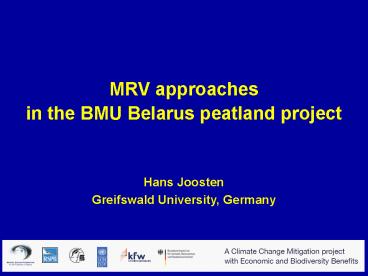MRV approaches - PowerPoint PPT Presentation
1 / 30
Title:
MRV approaches
Description:
Belarus has high proportion of peatlands... Present area of natural peatlands: ... may provide bypasses for increased CH4 via aerenchyma ('shunt species' ... – PowerPoint PPT presentation
Number of Views:103
Avg rating:3.0/5.0
Title: MRV approaches
1
- MRV approaches
- in the BMU Belarus peatland project
Hans Joosten Greifswald University, Germany
2
Eastern Europe famous for its vast and largely
undisturbed peatlands...
Rospuda Valley, Poland
3
Belarus has high proportion of peatlands...
fens (green), bogs (red), transitional peatlands
(purple) former extent 15 of the area
4
Present area of natural peatlands 1.5 mio ha
5
Present area of drained peatlands 1.5 mio ha
(agriculture 72, forestry 25, peat extraction
3)
6
Drained peatlands are huge emittors of CO2 N2O
7
CO2 emission
Central Europe is peatland emission hot spot
8
Does rewetting reduce greenhouse gas emissions?
9
How much less emissions after rewetting?
10
BMU funded rewetting project (2008-2011)
- builds on GEF funded rewetting project (42,000
ha) - strong support of Belarusian government
- carbon credits
- reduction of fires (radioactivity!)
11
BMU funded rewetting project (2008-2011)
- Deliverables
- methodology for GHG assessment
- standard for voluntary trade
- 15,000 ha rewetted and sustainably managed
- local capacity
12
Measuring directly is complicated, time
consuming, expensive ( 10,000 /ha/yr) ? proxy
indicators
13
Mean water level is best predictor of emissions
(meta-analysis of 25 site parameters in W-Europe)
14
CO2 emissions clearly correlate with water
levels they become less with higher water levels
15
CH4 emissions clearly correlate with water
levels they increase when higher than 20 cm -
surface
16
N2O emissions clearly correlate with water
levels they do not occur when higher than 15 cm
- surface
17
N2O erratic, but lower with higher water
levels Leave N2O emissions out ? conservative
estimate
18
By rewetting, greenhouse gas emissions decrease,
but less between 20 cm and 0 cm
19
Emissions strongly related to water level
Vegetation strongly related to water level ?
Use vegetation as indicator for emissions!
20
In an environmental gradient some plant species
occur together others exclude each
other. Species groups (and their absence!)
indicate site conditions much sharper than
individual plant species vegetation forms.
21
Vegetation types calibrated for GHG
emissions GESTs Greenhouse gas Emission Site
Types Some examples
Water level Vegetation CH4 CO2 GWP
22
GESTs with indicator species groups
Each GEST with typical species
Each GEST with typical GHG emissions
23
Benefits of vegetation as a GHG proxy
- reflects long-term water levels
- ? provides indication on GHG fluxes per yr
- is controlled by factors that control GHG
emissions (water, nutrients, acidity, land use) - is responsible for GHG emissions via its own
organic matter (root exudates!) - may provide bypasses for increased CH4 via
aerenchyma (shunt species) - allows rapid and fine-scaled mapping
- ? Vegetation is a more comprehensive proxy
than water level!
24
Disadvantages of vegetation as a proxy
- slow reaction on environmental changes
- 3 years before change in water level is
reflected in vegetation (negative effect faster) - needs to be calibrated for different climatic and
phytogeographical conditions
25
Vegetation forms developed for NE Germany
? test of correlations in Belarusian
peatlands
26
BMU Belarus project
- Calibration of NE German model for Belarus
- relation vegetation ? water level (CIM position)
- relation water level ? GHG emissions (CIM
position) - Completion of model (gap filling)
- Consistency test with international literature
- Development of conservative approaches
- Selection of rewetting sites
- Mapping of vegetation before rewetting
(assessment of emission baseline ) - Monitor water level and vegetation development
(ex-post emission monitoring)
27
Major gap abandoned peat extraction sites
28
- Perspectives of GEST-approach
- Ex-ante baseline assessment with ex-post
evaluation - Fine-scaled mapping
- Remote sensing monitoring
- Continuous refinement with progressing GHG
research - Addition of new modules (forest, transient
dynamics) - Simple, cheap, reliable
29
Developed with
- Jürgen Augustin (ZALF)
- John Couwenberg (DUENE)
- Dierk Michaelis (Uni Greifswald)
- Merten Minke (APB / CIM)
- Annett Thiele (APB/ CIM)
- And many more
30
GESTs!
info joosten_at_uni-greifswald.de

